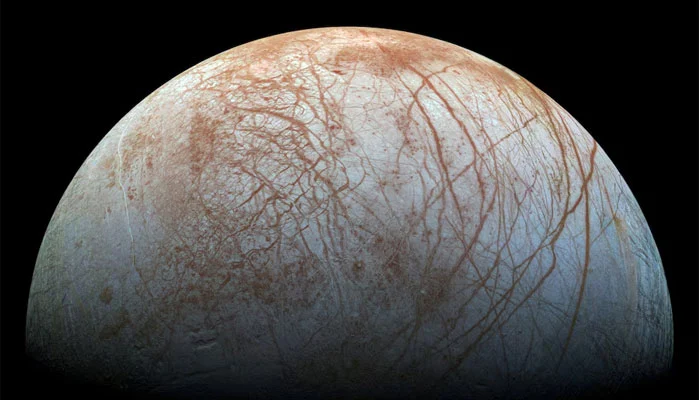
Introduction to Europa
One of Jupiter’s largest moons, Europa, has long captivated both space fans and scientists. Europa, which Galileo Galilei discovered in 1610, is somewhat smaller than the moon of Earth but has the potential to be one of the solar system’s most fascinating locations. It is a popular destination for investigation because of its frozen surface, enormous subterranean ocean, and the intriguing prospect of extraterrestrial life. Uncovering the mysteries beneath its frozen veneer will be the goal of NASA’s next Europa Clipper mission.
The majority of Europa’s surface is composed of water ice, and behind this icy exterior is thought to be an ocean of liquid water that is heated by the moon’s internal heat. Perhaps twice as much water as all the oceans on Earth combined, this ocean raises.
Why Europa? NASA’s Scientific Rationale
NASA is concentrating on Europa because there is strong indication that it could support life. Europa’s surface is relatively youthful compared to other moons, and it has few craters, which suggests that geological activity is still occurring. This activity raises the possibility that Europa may have the basic elements for life as we know it, especially given the availability of water and other necessary chemical components.
According to scientists, Europa’s subterranean ocean is where life, if it exists, would most likely be found. Under the ice, a dynamic environment where water and maybe nutrients can circulate is created by the heat produced by tidal forces, which are brought on by Jupiter’s gravitational pull. This setting is said to be comparable to the hydrothermal vents on the ocean bottoms of Earth, where life flourishes despite harsh circumstances.
The Europa Clipper Mission
NASA’s Europa Clipper mission aims to explore this icy moon in unprecedented detail. Scheduled for launch in the mid-2020s, the spacecraft will orbit Jupiter and conduct dozens of flybys of Europa, gathering data that could provide answers to some of the most pressing questions about this enigmatic world.
The mission’s primary goal is to determine whether Europa could support life. To achieve this, the Europa Clipper is equipped with a suite of scientific instruments designed to study the moon’s ice shell, its subsurface ocean, and the composition of its surface. Instruments like ice-penetrating radar, thermal imagers, and spectrometers will allow scientists to peer beneath Europa’s frozen surface and gather crucial data about its geology and potential habitability.
Exploring the Icy Surface
Europa’s surface is a complex and dynamic environment. The moon is covered in a thick layer of ice, with cracks, ridges, and chaotic terrain indicating a history of movement and resurfacing. These features suggest that the ice crust may be floating atop a global ocean, periodically interacting with the water below.
The Europa Clipper will use its instruments to analyze the ice and determine its thickness, structure, and composition. Understanding the properties of the ice is critical for interpreting the signs of activity beneath the surface and identifying areas where the ocean might be more accessible.
Probing the Subsurface Ocean
One of the most exciting aspects of the Europa Clipper mission is its potential to confirm the existence of a subsurface ocean. Scientists have long suspected that beneath Europa’s icy crust lies a vast body of liquid water, possibly tens of kilometers deep. The presence of water is a crucial factor in the search for life, and Europa’s ocean could provide a habitat for microbial life forms.
The spacecraft’s ice-penetrating radar will help map the ice-ocean interface, while other instruments will look for signs of water plumes erupting from the surface. These plumes, if confirmed, could provide direct access to the ocean’s chemistry, allowing scientists to study the water without needing to drill through the ice.
The Search for Extraterrestrial Life
Europa is one of the most promising places in our solar system to search for life beyond Earth. The combination of liquid water, heat, and chemical energy creates an environment where life, as we know it, could potentially exist. While scientists don’t expect to find large organisms swimming beneath Europa’s surface, microbial life is a real possibility.
The Europa Clipper will search for biosignatures—chemical signs of life—in the ice and water. These could include organic molecules, which are the building blocks of life, or other indicators like changes in the composition of the water that suggest biological processes at work.
Challenges of Exploring Europa
Exploring Europa presents a unique set of challenges. The moon orbits within Jupiter’s intense radiation belt, which poses a significant risk to both the spacecraft and any potential life on the surface. The Europa Clipper is specially designed to withstand this harsh environment, but the mission will require careful planning to minimize exposure to radiation.
In addition to radiation, the spacecraft must navigate the complex terrain of Europa’s surface. The ice crust is fractured and uneven, making it difficult to identify safe landing sites for future missions that may involve landers or robotic explorers.
Potential Discoveries: What’s at Stake?
The discovery of life on Europa would be one of the most significant scientific breakthroughs in history. It would not only confirm that life can exist beyond Earth but also provide insights into how life might evolve in extreme environments. Even if the mission doesn’t find definitive proof of life, studying Europa’s geology and ocean could reveal new information about the formation and evolution of moons and planets in our solar system.
Comparing Europa Exploration with Other Space Missions
The Europa Clipper mission differs from other planetary missions, such as those to Mars or Titan, in several key ways. While Mars exploration focuses on surface geology and the search for ancient life, Europa’s mission is centered on the possibility of life in an active, subsurface ocean. Titan, Saturn’s largest moon, has lakes of methane and ethane, making it a very different environment from Europa’s water-rich landscape.
Collaboration and Global Interest
NASA’s Europa Clipper mission is not being conducted in isolation. The mission involves collaboration with international space agencies and research institutions, reflecting the global interest in Europa and its potential for scientific discovery. European and Japanese



